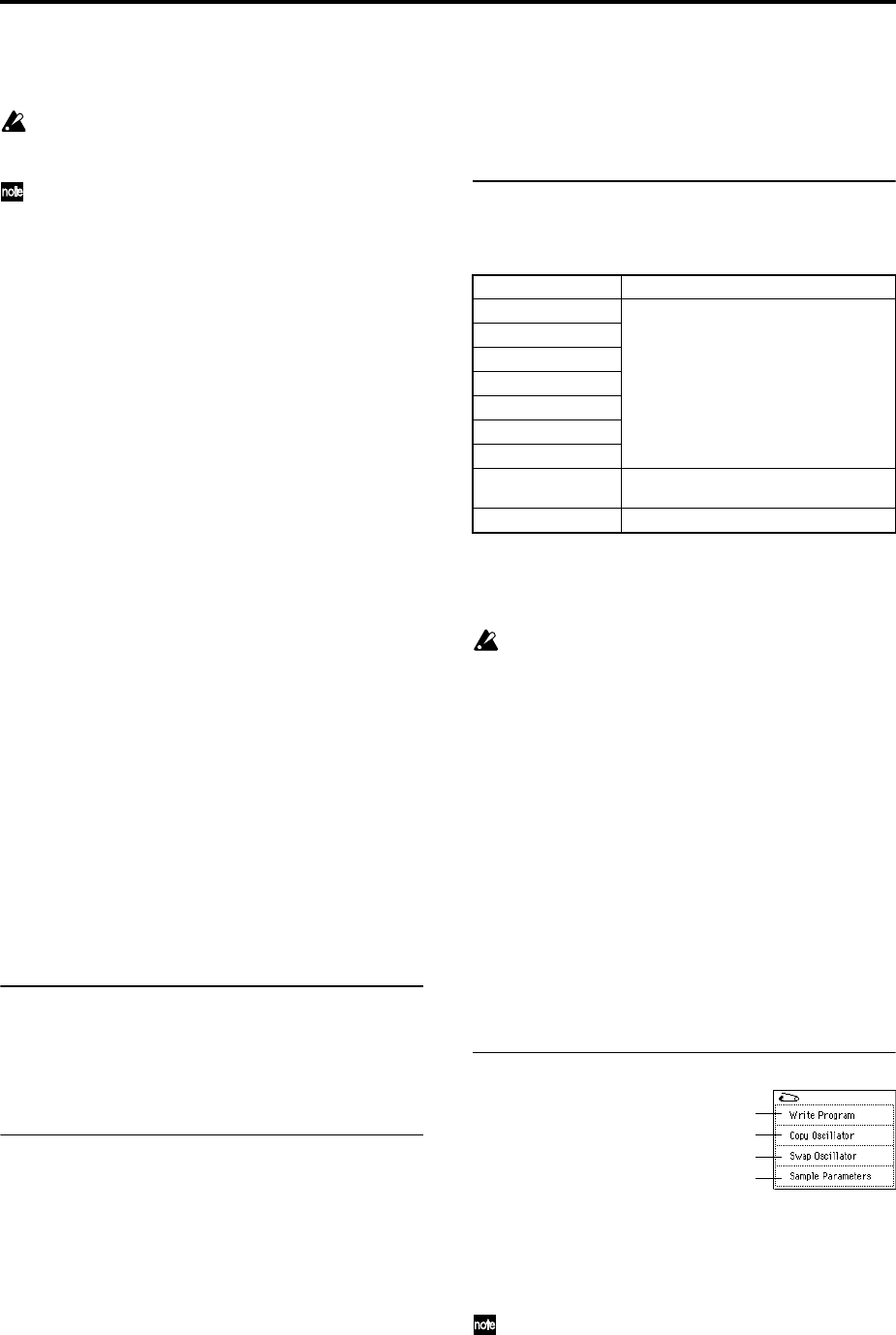
10
Lvl (High Level) [000…127]
Specifies the level of the multisample.
Depending on the multisample, high settings of this
parameter may cause the sound to distort when a chord
is played. If this occurs, lower the level.
The playback level for a RAM multisample is also
affected by the “+12 dB” (Sampling P2: 2–1c) setting for
each sample. If the “+12 dB” setting is on, the playback
will be approximately +12 dB louder. (☞0–3C)
Low:
Here you can assign the Low multisample for OSC1.
The multisample you select here will sounded by velocities
less than the value of the “Velocity M.Sample SW Lo→Hi”
(1–2c) parameter “OSC1.”
Low MS Bank [ROM, RAM, Piano, EXB*...]
Low Multisample
[000...424, 000...999, 000...003, 000...]
S.Offset (Low Start Offset) [Off, On]
Rev (Low Reverse) [Off, On]
Lvl (Low Level) [000…127]
☞For details on the “Low” parameters, refer to the explana-
tions for the corresponding “High” parameters.
Octave [–2[32’], –1[16’], +0[8’], +1[4’]]
Adjusts the pitch in octave units. The normal octave of the
multisample is pitched at 8' (feet).
Transpose [–12…+12]
Adjusts the pitch in semitone steps over a range of ±1
octave.
Tune [–1200…+1200]
Adjusts the pitch of the sample in one-cent steps (a semitone
is 100 cents) over a range of ±1 octave.
Delay [0ms…5000ms, KeyOff]
Specifies a delay time from note-on until the note will sound.
With a setting of KeyOff, the sound will begin when note-off
occurs. This is used to create sounds such as the “click” that is
heard when a harpsichord note is released. In this case, set the
Amp1 EG, Amp2 EG (4–3a, 4–6) “Sustain” parameter to 0.
1–2b: OSC2 Multisample
This will appear when “Oscillator Mode” (1–1a) is set to
Double.
For details on the settings and function of the parameter,
refer to “1–2a: OSC1 Multisample.”
1–2c: Velocity M.Sample SW Lo → Hi
(Velocity Multisample Switch Low → High)
OSC1 (OSC1 Velocity Switch) [1…127]
The High and Low multisamples selected for oscillator 1 in
“OSC 1 Multisample” (1–2a) will be switched at the veloc-
ity value that you specify here.
Notes played with a velocity stronger than this value will be
sounded by the High multisample.
OSC2 (OSC2 Velocity Switch) [1…127]
This will appear when “Oscillator Mode” (1–1a) is set to
Double.
The High and Low multisamples selected for oscillator 2 in
“OSC 2 Multisample” (1–2b) will be switched at the veloc-
ity value that you specify here.
Notes played with a velocity stronger than this value will be
sounded by the High multisample.
1–2d: Drum Kit
Drum Kit [000(I-A/B)...143(User), 144(GM)...152(GM)]
Selects a drum kit.
Octave [–2[32’], –1[16’], +0[8’], +1[4’]]
Adjusts the pitch in octave units. When using a drum kit, set
the Octave to 8'.
When editing a drum program, you must set this
parameter to 8'. With other settings, the sounds of the
drum kit will be assigned to the wrong notes of the key-
board.
Transpose [–12…+12]
This adjusts the location of the instruments in the selected
drum kit. Unless you need to change this, leave it at 0.
Tune [–1200…+1200]
This adjusts the pitch in one-cent units.
The pitch of each drum kit can be adjusted in Global P5:
Drum kit.
Delay (Delay Time) [0ms…5000ms, KeyOff]
This specifies a delay time from note-on until the sound will
begin.
With a setting of KeyOff, the sound will begin when note-
off occurs. In this case, set the Amp EG (4–3a) parameter
“Sustain” to 0.
▼ 1–2: Page Menu Command
1–2A: Sample Parameters
Specifies the sample for each index of a RAM multisample.
You can adjust the playback level, cutoff, resonance, pitch,
attack, and decay.
This can be selected if “Oscillator Mode” (1–1a) is Sin-
gle or Double, and RAM is selected as the “High MS
Bank” or “Low MS Bank” for OSC1 Multisample or
OSC2 Multisample and “High Multisample” or “Low
Multisample” are selected.
000(I-A/B)–015(I-A/B) Preloaded drum kits
16(E-A)–31(E-A)
User drum kits
EXB-PCM series drum kits
32(E-B)–47(E-B)
48(E-C)–63(E-C)
64(E-D)–79(E-D)
80(E-E)–95(E-E)
96(E-F)–111(E-F)
112(E-G)–127(E-G)
128(User)–143(User) User drum kits
(some preloaded drum kits)
144(GM)–152(GM) ROM preset drum kits compatible with GM2
0–1A
1–1A
1–1B
1–2A


















